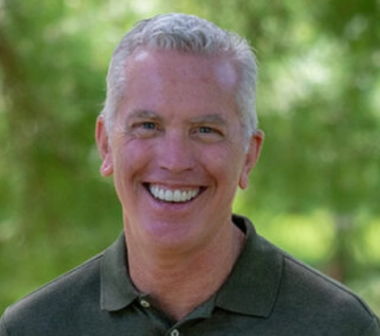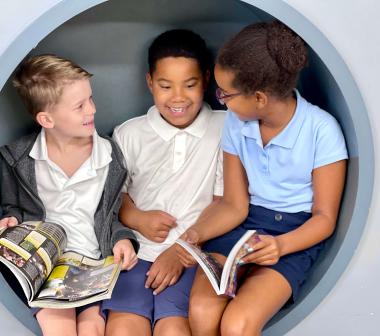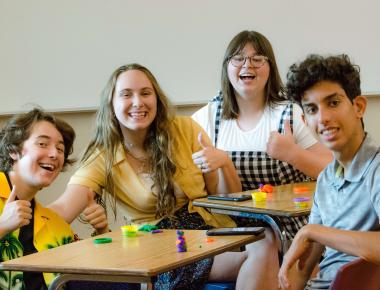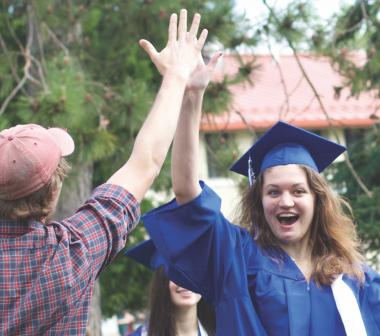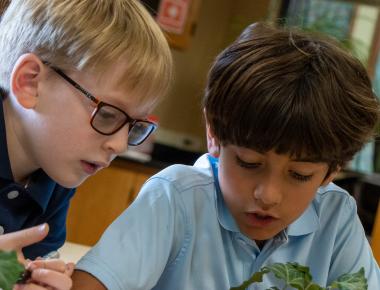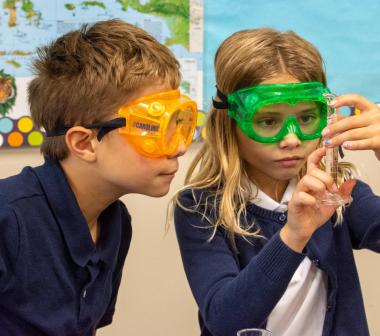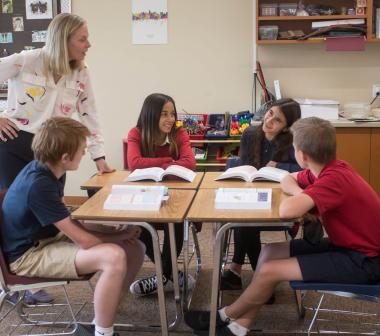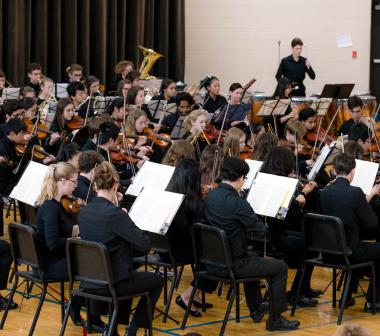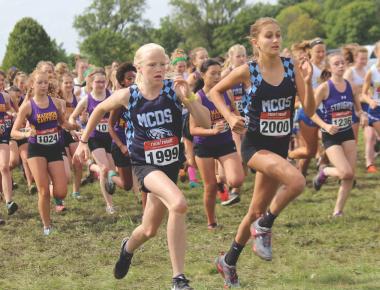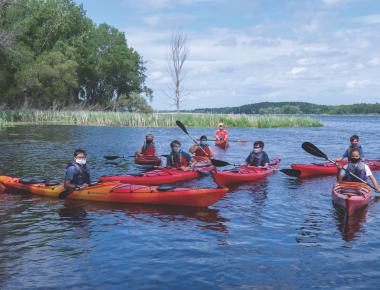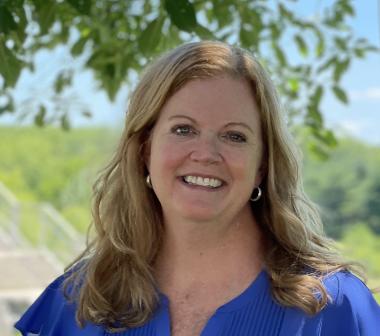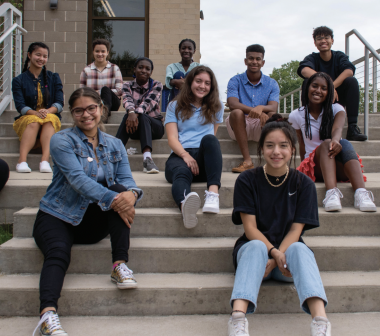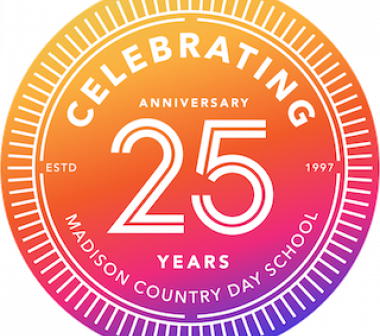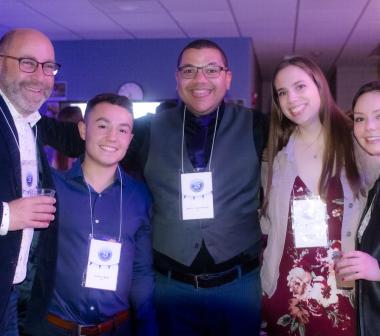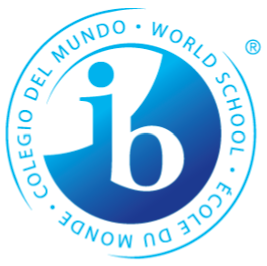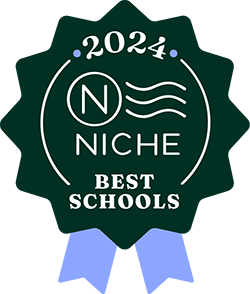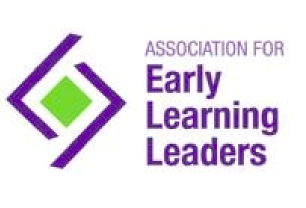Middle School
Grade 5
Middle School, and fifth grade in particular, is an exciting time of tremendous growth. The academic journey continues with IB’s Middle Years Programme (MYP). Language Arts, history, and geography are combined together into a vibrant Humanities course Students begin IB Integrated Math courses where they are building a strong foundation for math knowledge and understanding, investigating patterns, communication, and applying mathematics in real-life contexts. Music theory is enhanced with more options for ensemble and instrument lessons. Students have smaller advisory groups instead of homeroom, take on in-depth academic projects with technology and design, gain confidence in Socratic seminar-style classes that build analytical and discussion skills, and learn strategies to achieve personal goals.

Middle School Advisory
Advisory is a group of 10-12 students that meet three times a week with a faculty member. Advisory is a student's “home” within middle school. In addition to developing closer connections with peers and teachers, fifth grade advisory helps students with the transition into middle school. This can mean help with organization, time management, and setting academic and community goals. Themed units on communication, healthy relationships, conflict resolution, building trust, cooperation and self-reflection help students to thrive. Click here to learn more.
Grade 5 Curriculum:
Humanities
The Humanities model is the integration of reading and writing along with history and geography. In this model, students typically divide their time between reading and writing workshops coupled with the integration of history and geography. The reading workshop includes practicing reading comprehension strategies, such as making connections, questioning, visualizing, inferring, determining importance, and synthesizing information. Writing will explore evidence-based writing with crossover into history. In addition, writing will explore writing for various purposes and audiences. The historical focus for this school year is ancient civilizations centered around water. Students read and write across multiple genres in a disciplined and interactive classroom where project-based assessments meet the learning needs and styles of all students.
Math
IB Math 1 mathematics uses the Haese Mathematics 6 (MYP Year 1) third edition textbook. Guided by an understanding of place value, students practice whole number and decimal arithmetic. A study of fractions includes addition and subtraction of fractions of unlike denominators, the product of fractions, and division of a fraction by a whole number. Students work with ratio, percentage, average, rate, and line graphs. Students study the geometry of angles, the triangle, parallelogram, rhombus, trapezoid, cubes, and cuboids.
Discussions, activities, investigations, and research exercises are used throughout the units to develop conceptual understanding. Students are assessed on the following criteria: (A) Knowing and Understanding, (B) Investigating Patterns, (C) Communicating, and (D) Applying Mathematics in Real-life Contexts.
Science
A common theme of fifth grade is looking at energy. Students build on their understanding of matter and its properties by exploring how the properties and interactions of matter and energy explain physical and chemical changes
Students will develop their understanding of important qualitative ideas about energy including that the interactions of objects can be explained and predicted using the concept of transfer of energy from one object or system of objects to another, and the total change of energy in any system is always equal to the total energy transferred into or out of the system.
In their study of ecosystems students will collect, analyze and interpret data, develop models, construct arguments and demonstrate a deeper understanding of resources, the cycling of matter, and the flow of energy in ecosystems. When studying organisms’ systems and cells students will look at a more microscopic level to understand living things by investigating the cell, its structure, and how groups of cells contribute to the function of living things. In understanding cells, students will have a better context for the plant process of photosynthesis and the movement of matter and energy within a living system.
Students will be introduced to how atomic and molecular interactions explain the properties of matter that we see and feel. They will investigate properties of matter and begin to explore states of matter and how matter changes from one state to another. In these investigations, students will continue to apply their understanding of energy. Students will also explore the difference between energy and temperature, learn the basics of the thermal energy, and apply what they know to engineer a device that applies their understanding of these concepts. Students will continue to build on science and engineering skills in their application of knowledge. The core goals of the course are listed below. These skills are intricately tied to the standards for assessment for each content area.
Science Core Goals
- Develop science and engineering skills through hands on investigations.
- Gather, interpret, and synthesize data to make appropriate conclusions.
- Construct and support arguments with accurate and relevant evidence.
- Improve skills in scientific writing.
- Work cooperatively with lab partners to successfully complete projects, apply concepts, and share arguments in an intellectually respectful manner.
- Design, create, and/or use models to represent scientific ideas or concepts.
- Communicate ideas effectively with others.
Spanish
In the Middle School language acquisition class, we believe language is an essential tool to develop students’ intercultural awareness. Global citizens are those who accept and respect different perspectives in order to have a better understanding of the world. Acquiring a new language is the best way to be exposed to other cultures and understand, accept, and appreciate differences. The main goal of this class is to develop all language skills: writing, listening, speaking, reading, viewing, and interpreting. Students aim to achieve communicative competence by actively participating in class using a communicative approach. Students are encouraged to use the target language in real-life contexts according to their age and proficiency level. In fifth-grade Spanish class, students will develop the language by exploring their personal experiences and connecting them to the course content. Some of the topics include School Life, How do we Learn? Family, Daily Routine, How do we use our free time? Grammar focuses on the correct use of the Present Tense of regular and irregular verbs, stem-changing verbs and reflexive verbs, and pronouns. Additionally, students will be able to express likes and dislikes.
Music
The Madison Country Day School Music Department strives to provide a comprehensive music education for each child, promoting a balance of discipline, creativity, and aesthetic understanding.
When starting middle school in fifth grade, students choose an instrument (piano, voice, violin, viola, cello, bass, trumpet, trombone, french horn, oboe, clarinet, saxophone, flute, or percussion). Beginning in fifth grade, and throughout middle school, students receive private or semi-private music lessons on their instrument. These lessons occur during the school day and are included in tuition. All fifth grade students participate in a combined fifth and sixth grade ensemble (band, choir, or orchestra) determined by their instrument. These young musicians perform in a Winter and Spring concert and can also participate in two recitals each year. Depending on their ensemble, students have other performance opportunities, both on and off campus. Fifth and sixth grade students receive designated instruction time in music theory during their ensembles. Units include major vs. minor tonality, rhythm/meter, and scale construction/key signatures. A major highlight is the annual composition unit. MCDS music students grades 5-12 are given an account with Noteflight, a web-based notation software, which they use for composition as well as music assessments.
Art
Middle school art consists of studio work with a variety of different artistic mediums, completing written artist statements for an online portfolio, and group critiques to learn how to talk about artwork. The elements and principles of art and design are the vocabulary words we start to unpack and learn about to describe art. We will be exploring a variety of topics in art this year including, but not limited to, art history, artist studies, learning about new techniques to use with a variety of mediums, and student choice projects. These choice projects will have a theme or topic to guide students along their artistic journey. Once projects are completed, students will share how and why they chose to create their art and how it fits into the theme or topic, allowing for more individual expression and interpretation.
Physical Education
In fifth grade students will be able to outline physical and health education-related factual, procedural and conceptual knowledge, apply physical and health terminology to communicate understanding, recall and apply a range of skills and techniques, and describe and summarize performance. Some of the activities covered include paddling, touch rugby, golf, disc golf, kickball, health, cross country skiing, fitness, tennis, among others. Students also develop the confidence and motivation to participate in organized and individual physical activities where they learn leadership, teamwork, and good sportsmanship.
There is a wonderfully positive atmosphere at MCDS Middle School which stems from the daily interactions of students with their teachers. Our son has gone through a remarkable transformation since coming to MCDS in fifth grade. He shows an excitement for learning and studying like we’ve never seen in him before.


